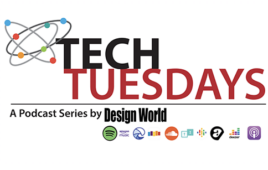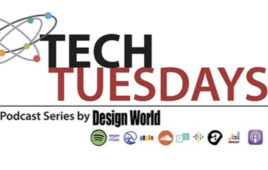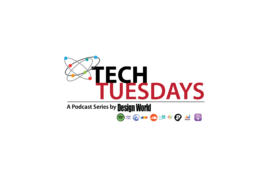Gordon Styles, president and CEO of Star Rapid, a service provider in China takes a look at some of the changes he sees coming to additive manufacturing. Styles looks at plastic and metal 3D printing, and how metal desktop 3D printers may affect the manufacturing landscape.
For those who prefer to read the transcript:
Hello, everyone. I’m Leslie Langnau, Managing Editor at Design World magazine, and I’m here today with Gordon Styles, President and CEO of Star Rapid, a company that provides high-quality prototyping, rapid tooling, and low-volume manufacturing services. Gordon is going to offer several insights into what could happen with 3D printing in the near future, so thank you for joining me today, Gordon.
Gordon: Thank you very much. Pleasure to be with you.
Leslie: Okay, so let’s start out with what are some of the trends you see in plastic 3D printing in the near future?
Gordon: Well, one of the things that I’m seeing at the moment, certainly over the last year, is an ongoing and long-term reduction in the price of plastics 3D printing, particularly here in China. Over the last three years, we’ve seen the price here for plastic 3D printing probably reduced by up to 50%, so it’s gone down a long way compared to what it was just three, four years ago.
One of the things that is driving that, obviously, is machines with increased productivity. Although it hasn’t had a great effect here in China, it’s certainly starting to have an effect in the West, is the new Hewlett Packard MJF machine, their fusion technology, which … I actually have a friend in India who’s a reseller for them, and he’s been running them quite extensively. He says that he’s seeing they are faster. They’re not as fast as was being claimed before launch, but they are faster, and there are lower costs, and I think you’re going to see that the key company that will be affected by that is probably EOS and their SLS technology because the MJF is very much competing in their space. I think we’re going to see quite the battle over the next 12 months between HP and EOS in that space for nylon parts, strong nylon parts. The quality’s pretty good. I’ve seen quite a lot of the parts, and they’re very nice. So that’s a couple of things in plastics.
Leslie: Well, that’s kind of interesting because there’s a lot of emphasis, at least here in the United States, about metal 3D printing. Plastic 3D printing has been around for a while, but what do you think might be needed in order for plastic 3D printing to play an even stronger role in this industry?
Gordon: Well, there’s some big challenge for plastics and metals competing with existing manufacturing processes. For example, in plastics, you’re up against plastic injection molding. That’s an extremely efficient process compared to 3D printing, exceptionally fast in comparison, especially if you need thousands of parts. I think where plastic 3D printing and metal 3D printing will make their mark in, for example low-volume production, is where those parts solve a design problem where the parts cannot be made by any other traditional method.
For example, even though I’m in my 50s, I’m actually doing the Invisalign braces for moving my teeth. I’m just finishing a year-long course, actually. Every single one of those braces is thermoformed over a stereolithography 3D-printed master model, and you can even see the layers in the braces. The reason why that is successful is because every single brace is different. I got a set of 53, and every single one is ever-so-slightly different. Although it is mass production in a way because Invisalign make, probably, millions of these trays, as they call them, but every single tray is different, but it’s like a manufacturing process, mass customization, if you wish, and that’s one example.
In metals, metals is taking a long time to find its niche, to really find applications because it is wickedly expensive. I mean it genuinely is wickedly expensive, so you’ve got to have some kind of application that can really absorb that cost, where you really need that value-added, the making of a part that simply cannot be made by some other process.
Leslie: Now, do you use any kind of desktop metal 3D printers in your services?
Gordon: Well, we still contract to that style of like printed with sintering afterwards. We have our own metals printer, like a Renishaw AM250, but that’s metal welding, if you like. That’s melting as opposed to sintering, which is a fundamentally different proposition.
Leslie: What kind of developments do you see with metal 3D printing in desktop-type printers coming in the near future?
Gordon: Well, there are a number of other companies who have very similar offerings to them, but as I said, they’ve held back from actually launching machines because of the problems of controlling the thermal part of the … the sintering part of the process, if you like. I think the next couple of the years is the year when we’ll see probably two or three people launch machines in similar nature because I think Desktop Metal prompted the other players to finally get off the pot and launch their machines.
Leslie: Okay. Now, 3D printing is definitely gaining hold in certain industries like aerospace, and certainly medical, and even some automotive. What do you think needs to happen in order for 3D printing to be used in a greater range of applications?
Gordon: Yeah. On this one, I’ll speak to the metals side because plastics, frankly, fairly easy to design for, but in metals, designing a part that is appropriate for 3D metal printing is very, very difficult. You actually have to sit down with a manufacturer or do your own research, and you’ve got to learn how these machines actually work, how the supports are built, how they’re designed, how they’re attached, and you’ve got to learn how to orient parts, how to design a part so it’s self-supporting as it’s being built and so forth. We’ve done a lot of that in the last year, teaching clients how to design for it. Now, we’ve actually just done a case study on a Brazilian lady, and we’ve got the case study on our website, some beautiful parts, all self-supporting, and all this happened after she came and visited us, spent a couple of weeks learning how to design for it, even playing with the machine and actually building some parts.
We’re just doing a very, very unique project, at the moment, for a pen that’s being designed specifically for metal printing, highly-efficient build, almost no supports, and because we can put a lot of them together on one machine, we can be quite efficient with the price. It is possible to use this process, but you’ve got to learn how to use it, got to learn how to design for it. That’s going to be the big thing this year, I think. People, more and more, are learning how do this, teaching how to use the technology.
Leslie: Great. Well, thank you very much for your time, Gordon. I appreciate it.
Gordon: Oh, you’re very welcome, Leslie. Anytime.
Filed Under: 3D printing • additive • stereolithography, PODCASTS




Tell Us What You Think!